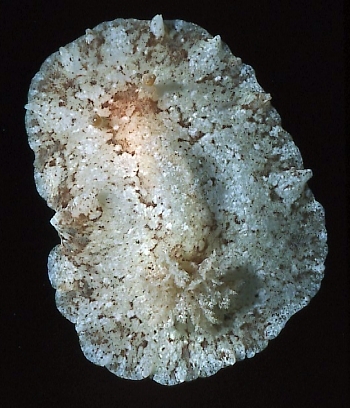
Platydoris inframaculata
(Abraham, 1877)
Order: NUDIBRANCHIA
Suborder: DORIDINA
Superfamily: EUDORIDOIDEA
Family: Dorididae
DISTRIBUTION
Probably wide Indo-West Pacific distribution. Reported from Indonesia, Philippines and Sri Lanka (Dorgan, 2006). Records in Forum from Tanzania and New Caledonia.
PHOTO
Upper right; Lower left: Passe du Baron, off Koumac, New Caledonia, 20°33.7'S, 164°10.3'E, 12m, In lagoon, sand with Heteropsammia, 14 October 1993, 63 mm long alive, AM C200480. Lower right: S of Île Rédika, (S Lagoon), 23 m, 18 October 1988, in coral sand patch with Halimeda and Caulerpa, coll: P.Laboute, AM C156645. Photos: Bill Rudman.
In a recent revision (Dorgan et al, 2006) of the genus Platydoris, this large dorid, with a rather nondescript dorsal colour pattern of mottled white, pink and browns is identified as Platydoris inframaculata (Abraham, 1877). As Dorgan et al note, its most distinctive external feature is the bright white underside with a spectacular pattern of red splashes on the underside of the mantle and the side of the foot and a yellow or orange ring running round the mantle about midway out. Abraham's description is based on a preserved decolourised Platydoris. Although he mentions brown spots of different sizes, a number of species of Platydoris have brown spots ventrally. Also, as I illustrate here, this 'distinctive' colour pattern is not always present.
In many specimens the ventral side of the mantle is brilliantly coloured white with large and smaller red spots scattered over the inner half. More small red spots form a band around the mantle about halfway out. This band is overlain with a broad band of orange. In some specimens, however, the red and orange ventral colour pattern is replaced by an aggregation of dark brown spots on the inner half of the mantle. Usually there is a faint trace of the yellow-orange band [lower left photo], but in some specimens it is almost impossible to see. While the red and orange colour pattern would probably be recognisable in earlier descriptions - especially if the outer ring of small red spots is present, it is not possible to determine if one or more of the many early descriptions of mottled brown dorids, applies to the colour form of this species which only has brown spots ventrally.
In New Caledonia it is associated with, and well-camouflaged on, soft sandy substrates and a specimen from Tanzania (personal observation) half-buried in sand in an aquaria. The species Eliot (1904) reported from Kenya as Platydoris ellioti? (A. & H.) has a ventral colour pattern with brown spots and an orange band. It is clearly this species and not Platydoris ellioti (Alder & Hancock) . It is possible that the species reported by Pruvot-Fol (1954) from Hikuera, as Austrodoris ellioti, is this species.
See message #20084 discussing the use of the name P. inframaculata
-
Abraham, P.S. (1877). Revision of the Anthobranchiate nudibranchiate mollusca, with descriptions or notices of forty-one hitherto undescribed species. Proc. Zool. Soc. London, 1877: 196-269.
-
Alder, J. and Hancock, A. (1864) Notice of a collection of nudibranchiate mollusca made in India by Walter Elliot Esq., with descriptions of several new genera and species. Transactions of the Zoological Society of London 5: 113-147.
-
K.M. Dorgan, A. Valdes and T.M. Gosliner. (2002) Phylogenetic systematics of the genus Platydoris (Mollusca, Nudibranchia, Doridoidea) with descriptions of six new species. Zoologica Scripta, 31: 271-319.
-
Eliot, C.N.E. (1904) On some nudibranchs from East Africa and Zanzibar. Part III. Dorididae Cryptobranchiatae, I. Proceedings of the Zoological Society of London, 1903(2): 354-385, Pls.32-34.
-
Pruvot-Fol, A. (1954) Etude d'une petite collection d'opisthobranches d'Oceanie francaise. Journal de Conchyliologie, 94(1): 3-30.
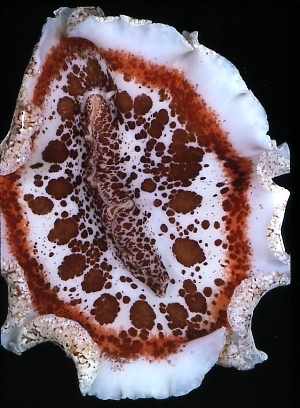
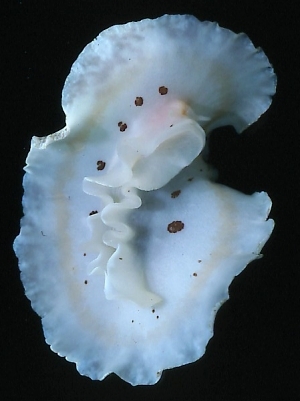
Rudman, W.B., 2007 (June 28) Platydoris inframaculata (Abraham, 1877). [In] Sea Slug Forum. Australian Museum, Sydney. Available from http://www.seaslugforum.net/find/platinfr
Related messages
Re: Platydoris inframaculata from Reunion Island
August 8, 2008
From: Gary Cobb
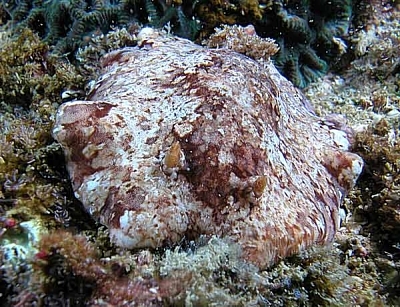
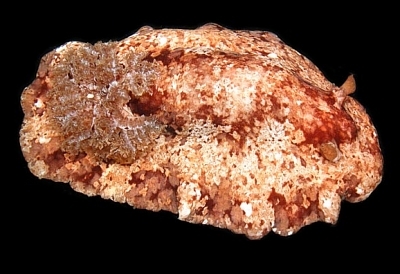
Concerning message #21474:
Hi Bill and everyone!
Nice to see Platydoris inframaculata in the spotlight. It amazes me the colour variations of this animal. Yet the ventral view is amazingly similar!
Locality: Mooloolaba, Sunshine Coast, 20 m, Queensland, Australia, Pacific Ocean, 21 August 2004, Subtidal. Length: 85 mm. Photographer: Gary Cobb.
Cheers,
Gary
gary@nudibranch.com.au
Cobb, G.C., 2008 (Aug 8) Re: Platydoris inframaculata from Reunion Island. [Message in] Sea Slug Forum. Australian Museum, Sydney. Available from http://www.seaslugforum.net/find/21771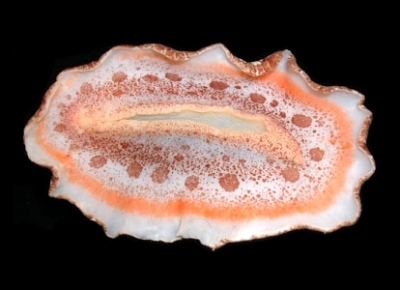
Thanks Gary,
Without the colour pattern on the underside I would have been reluctant to identify the orange animals in the previous message as this species. However the colour pattern on the underside needs to be treated with caution as I am sure I have collected animals which are this species, which lack any trace of this colour pattern. When present, even in a very 'faded' state, the pattern appears to be a reliable species indicator, but when absent, it absence can mislead us into thinking it is another species.
Best wishes,
Bill Rudman
Platydoris inframaculata from Reunion Island
August 5, 2008
From: Hugues Flodrops
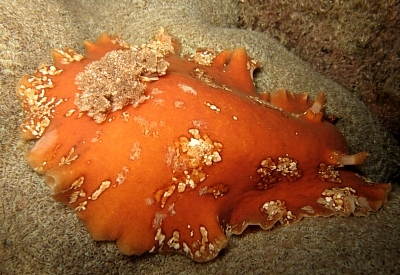
Concerning message #18679:
Dear Bill,
Here is pictures of a big dorid - size about 180 mm. The mantle skin is very firm to touch. For the fact sheet, I send a picture of the underside of the mantle. I don't see purplish blue patches but my best guess is Platydoris pulchra.
Locality: Etang-Salé "Permanent Pool", 2 metre, Reunion Island, Indian Ocean, 30 january 2008, Night. Length: 180 mm. Photographer: Hugues Flodrops.
Thanks for your help once again and regards.
Hugues.
hugues.flodrops@wanadoo.fr
Flodrops,H., 2008 (Aug 5) Platydoris inframaculata from Reunion Island. [Message in] Sea Slug Forum. Australian Museum, Sydney. Available from http://www.seaslugforum.net/find/21474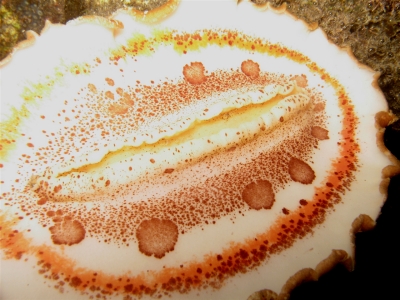
Dear Hugues,
Your animal certainly is similarly coloured to P. pulchra but the purplish patches are characteristic. More importantly, the photo of the underside of your animal clearly shows that it is Platydoris inframaculata. No other species has that distinctive pattern. We have to be careful though, because as I discuss [message #20084], the pattern can sometimes be very faint, or possibly absent.
Best wishes,
Bill Rudman
Platydorid from Lembeh St, Indonesia
April 22, 2008
From: Heidi Hösel
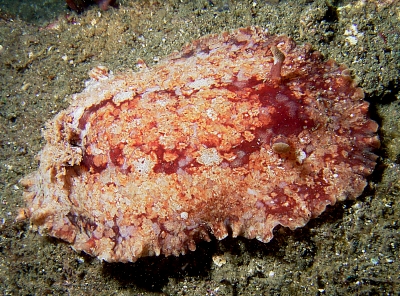
Dear Mr. Rudman
In the last four years my husband and I found in the Lembeh strait a variety of nudibranchs, we could not identify. This huge Platydorid (about 18 cm) that we saw in 2005, is one example. This year we found a second specimen with same pattern but about half the size. Both specimen were found and were active at night. I wonder whether it can be grouped into Platydoris speciosa or Platydoris ellioti?
Locality: Nudi Falls, Lembeh strait, 13m, N-Sulawesi Indonesia, Pacific, August 2005, rubble and sandy areas. Length: about 18 cm. Photographer: Heidi Hösel.
Thank you for your help in advance
Heidi Hösel
hhoesel@gmx.de
Hösel, H., 2008 (Apr 22) Platydorid from Lembeh St, Indonesia. [Message in] Sea Slug Forum. Australian Museum, Sydney. Available from http://www.seaslugforum.net/find/20844Dear Heidi,
Platydoris ellioti and P. speciosa are the same species. However I am afraid that there are a number of these large species of Platydoris with a very similar brown mottled mantle. I suspect your animal is Platydoris inframaculata rather than P. ellioti, but the only way to be sure is to look at the colour pattern of the underside of the mantle - and that's not possible with a photo.
Best wishes,
Bill Rudman
Re: Platydoris inframaculata from New Caledonia
April 17, 2008
From: Gary Cobb
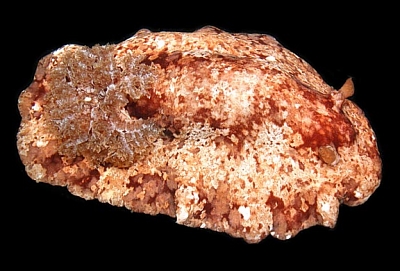
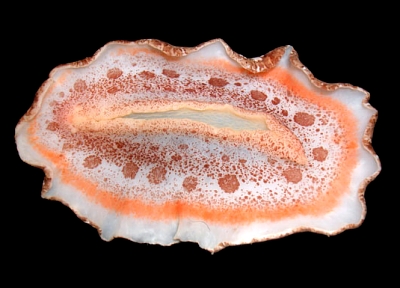
Concerning message #20084:
Hi Bill and everyone!
I noticed the Forum does not have very many entries for Platydoris inframaculata. Here is an animal we found under a rock of Mooloolaba at a dive site called Castle Rock.
The distinctive ring and spots are very prominent.
Locality: Mooloolaba, Sunshine Coast, 20m, Queensland, Australia, Pacific Ocean, 21 August 2004, Subtidal. Length: 85mm. Photographer: Gary Cobb.
Cheers,
Gary Cobb
gary@nudibranch.com.au
Cobb, G.C., 2008 (Apr 17) Re: Platydoris inframaculata from New Caledonia. [Message in] Sea Slug Forum. Australian Museum, Sydney. Available from http://www.seaslugforum.net/find/21426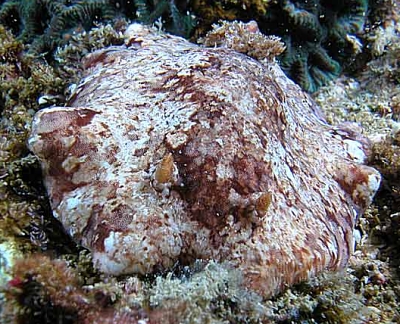
Dear Gary,
Thanks for this record. When an animal has the distinctive red and orange markings on the underside of the mantle it is easily distinguishable, but as I note on the Fact Sheet for the species, some animals have little or no sign of these markings. And as the animal was described from a decolourised specimen I am afraid there are always going to be some doubts about which species Abraham was really naming. Despite all that, it is certainly one of the most brilliantly coloured 'undersides' in the animal kingdom. It is possibly an example of Deimatic display [see Opisthobranch Defence] where an otherwise camouflaged animal can produce a bright colour pattern to startle a predator, but we have no evidence for that.
Best wishes,
Bill Rudman
Platydoris inframaculata from New Caledonia
July 2, 2007
From: Bill Rudman
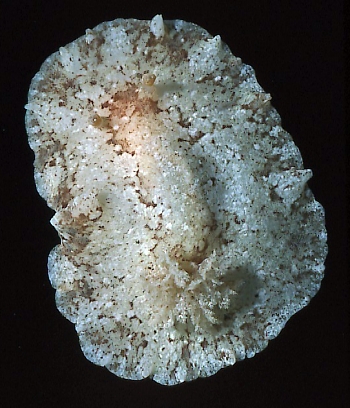
In a recent revision (Dorgan et al, 2006) of the genus Platydoris, this large dorid, with a rather nondescript dorsal colour pattern of mottled white, pink and browns is identified as Platydoris inframaculata (Abraham, 1877). I have encountered this dorid in both East Africa and the Western Pacific and had been unable to satisfactorily identify it with any published name. As Dorgan et al note, its most distinctive external feature is the bright white underside with a spectacular pattern of red splashes on the underside of the mantle and the sides of the foot, and a yellow or orange ring running round the mantle about midway out. What is surprising is that Abraham's 1877 paper is a classic example of a museum curator gone mad. He essentially named every preserved unlabelled nudibranch specimen in the collection of the Natural History Museum, London, despite knowing nothing about their living shape or colour. Although many of his names have been used, such as Archidoris wellingtonensis, because there is only one species looking like it in New Zealand, that is not the case of a preserved decolourised Platydoris. Abraham mentions brown spots of different sizes being present ventrally, but as a number of species of Platydoris have brown spots ventrally, it seems risky to use Abraham's name. Also, as I illustrate here, this 'distinctive' colour pattern is not always present.
In many specimens the ventral side of the mantle is brilliantly coloured white with large and smaller red spots scattered over the inner half. More small red spots form a band around the mantle about halfway out. This band is overlain with a broad band of orange. In some specimens, however, the red and orange ventral colour pattern is replaced by an aggregation of dark brown spots on the inner half of the mantle. Usually there is a faint trace of the yellow-orange band [lower left photo], but in some specimens it is almost impossible to see. While the red and orange colour pattern would probably be recognisable in earlier descriptions - especially if the outer ring of small red spots is present, it is not possible to determine if one or more of the many early descriptions of mottled brown dorids, applies to the colour form of this species which only has brown spots ventrally.
In New Caledonia it is associated with, and well-camouflaged on, soft sandy substrates and a specimen from Tanzania (personal observation) half-buried in sand in an aquaria. The species Eliot (1904) reported from Kenya as Platydoris ellioti? (A. & H.) has a ventral colour pattern with brown spots and an orange band. It is clearly this species and not Platydoris ellioti (Alder & Hancock) . It is possible that the species reported by Pruvot-Fol (1954) from Hikuera, as Austrodoris ellioti, is also this species. I follow Dorgan et al in identifying this as P. inframaculata, but have great doubts on whether we can ever be sure.
Upper right; Lower left: Passe du Baron, off Koumac, New Caledonia, 20°33.7'S, 164°10.3'E, 12m, In lagoon, sand with Heteropsammia, 14 October 1993, 63 mm long alive, AM C200480. Lower right: S of Île Rédika, (S Lagoon), 23 m, 18 October 1988, in coral sand patch with Halimeda and Caulerpa, coll: P.Laboute, AM C156645. Photos: Bill Rudman.
-
Abraham, P.S. (1877). Revision of the Anthobranchiate nudibranchiate mollusca, with descriptions or notices of forty-one hitherto undescribed species. Proc. Zool. Soc. London, 1877: 196-269.
-
Alder, J. and Hancock, A. (1864) Notice of a collection of nudibranchiate mollusca made in India by Walter Elliot Esq., with descriptions of several new genera and species. Transactions of the Zoological Society of London 5: 113-147.
-
K.M. Dorgan, A. Valdes and T.M. Gosliner. (2002) Phylogenetic systematics of the genus Platydoris (Mollusca, Nudibranchia, Doridoidea) with descriptions of six new species. Zoologica Scripta, 31: 271-319.
-
Eliot, C.N.E. (1904) On some nudibranchs from East Africa and Zanzibar. Part III. Dorididae Cryptobranchiatae, I. Proceedings of the Zoological Society of London, 1903(2): 354-385, Pls.32-34.
-
Pruvot-Fol, A. (1954) Etude d'une petite collection d'opisthobranches d'Oceanie francaise. Journal de Conchyliologie, 94(1): 3-30.
Bill Rudman
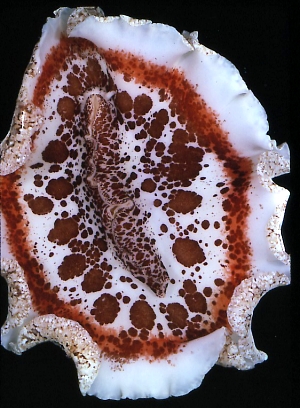
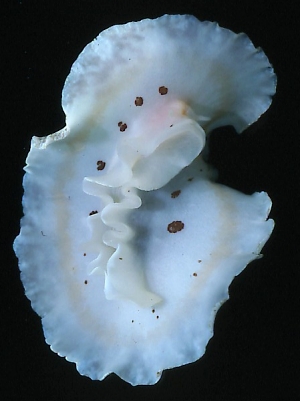
Platydoris inframaculata from the Red Sea
July 2, 2007
From: Ing. Harald Sapper
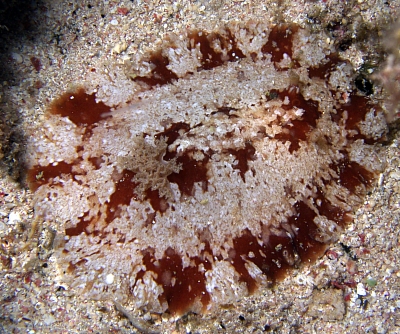
Hello!
Please can You help me to identify this sea slug.
Locality: Dahab, 5 m, Egypt, Read Sea, 5 July 2005. Length: 7 cm. Photographer: Ing. Harald Sapper.
Thanks in advance
Harald Sapper
h.deepstop1@chello.at
Sapper, H., 2007 (Jul 2) Platydoris inframaculata from the Red Sea. [Message in] Sea Slug Forum. Australian Museum, Sydney. Available from http://www.seaslugforum.net/find/19567Dear Harald,
It is a bit difficult to be sure with these flat dorids which look like patches of sand, but I think this is Platydoris inframaculata
Best wishes,
Bill Rudman
